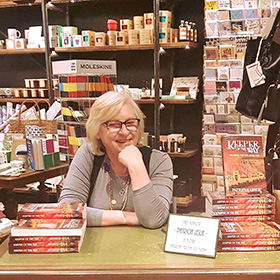 Relevant History welcomes Patricia Leslie, a Sydney author with a passion for combining alternative history, fantasy, and action into stories that nudge at the boundaries of reality. In Keeper of the Way, Patricia “solves” a mystery over 100 years old: the destruction of the magnificent Garden Palace. “Magic,” Patricia says, “is an ages old fall back when dealing with the unexplainable.” Many of the characters are based on her own family history—and one woman in particular who emigrated from Scotland bringing magical traditions and supernatural links on the long journey to the New World. To learn more about her and her books, visit her web site, and follow her on Facebook, Twitter, and Instagram.
Relevant History welcomes Patricia Leslie, a Sydney author with a passion for combining alternative history, fantasy, and action into stories that nudge at the boundaries of reality. In Keeper of the Way, Patricia “solves” a mystery over 100 years old: the destruction of the magnificent Garden Palace. “Magic,” Patricia says, “is an ages old fall back when dealing with the unexplainable.” Many of the characters are based on her own family history—and one woman in particular who emigrated from Scotland bringing magical traditions and supernatural links on the long journey to the New World. To learn more about her and her books, visit her web site, and follow her on Facebook, Twitter, and Instagram.
*****
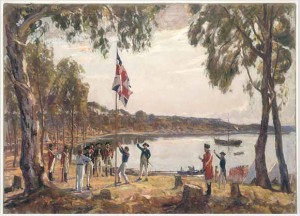 It takes more than a surface look to see the levels of history on display in Sydney. Especially, if you’ve come from a country where an old building could be anywhere from 200 to 700 years, where crumbling ruins dot the landscape and point to a built-history much older, more fraught with intrigue and story than anything you’ll see in Australia. Stories here are layered. From the Gadigal who inhabited the area for thousands of years before the first European ship sailed into the harbour, to the French who weren’t particularly interested in staying, to the English who not only dropped their anchor but stuck a flagpole into the ground and laid claim.
It takes more than a surface look to see the levels of history on display in Sydney. Especially, if you’ve come from a country where an old building could be anywhere from 200 to 700 years, where crumbling ruins dot the landscape and point to a built-history much older, more fraught with intrigue and story than anything you’ll see in Australia. Stories here are layered. From the Gadigal who inhabited the area for thousands of years before the first European ship sailed into the harbour, to the French who weren’t particularly interested in staying, to the English who not only dropped their anchor but stuck a flagpole into the ground and laid claim.
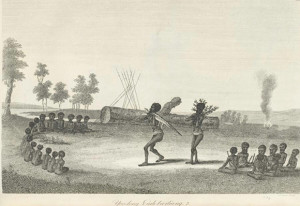 From 1788 onward, people came in droves; willingly, non-willingly, eyes wide open, or blurred with exaggerations, they overwhelmed the native population through sheer-number. Stories and pictures distributed around the colony and to Britain showed a dream-land where native people were marginalised (through stereotype or lack of depiction).
From 1788 onward, people came in droves; willingly, non-willingly, eyes wide open, or blurred with exaggerations, they overwhelmed the native population through sheer-number. Stories and pictures distributed around the colony and to Britain showed a dream-land where native people were marginalised (through stereotype or lack of depiction).
Move forward one hundred years from the arrival of the first fleet, and Gadigal land is built upon, fenced, and controlled; people are ravaged by disease and displacement. Families still camp around the foreshores and fish in the harbour, they travel through and around their homeland now etched with English culture and industry. They haven’t vanished, but for many of the colonial inhabitants of Sydney, they are reduced to newspapers stories, cartoons, and museum collections.
International exhibition in 1879
In February 1878, it was decided that Sydney would host a grand exhibition in a specially built venue. The Royal Agricultural Society was to run the project, but when it became clear the Society didn’t have the capacity for the mammoth task it was taken over by the Premier of New South Wales, Henry Parkes (who’d been itching to get his hands on it). The Colonial Architect, James Barnet, was given instruction to get moving in November 1878. Land from the Governor’s stables (now the Conservatorium of Music) to the Sydney Free Library (on the site of the State / Mitchell Library) was dedicated to the project. Barnet had nine months.
The Australian Museum was approached to loan its ethnological collection to the exhibition. While the curator, Edward Ramsey, collected and organised thousands of items for the display, James Barnet sat at his drawing board and put his vision to paper. His designs would take a step or two beyond his usual grand government buildings as he let his fancies fly with a Victorian Italianate design popular in Australia at that time.
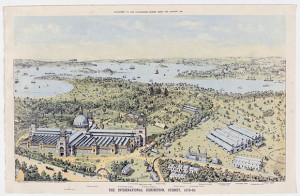 Drawings were completed in January 1879, and John Young, who’d worked on London’s Crystal Palace, Sydney’s General Post Office, and the Prince Alfred Park Exhibition building, was contracted. To facilitate the deadline, Young imported electric lighting to enable the labour force of 1500 men to work around the clock in three shifts. The foundation stone was laid (by Lady Robinson, Honourable Nea Arthur Ada Rose D’Amour) in February, and by 17 September the Exhibition was open, and the first of 20,000 people started filtering through (that was just on opening day). By the time the exhibition closed seven months later, over 1 million people had stepped through the doors.
Drawings were completed in January 1879, and John Young, who’d worked on London’s Crystal Palace, Sydney’s General Post Office, and the Prince Alfred Park Exhibition building, was contracted. To facilitate the deadline, Young imported electric lighting to enable the labour force of 1500 men to work around the clock in three shifts. The foundation stone was laid (by Lady Robinson, Honourable Nea Arthur Ada Rose D’Amour) in February, and by 17 September the Exhibition was open, and the first of 20,000 people started filtering through (that was just on opening day). By the time the exhibition closed seven months later, over 1 million people had stepped through the doors.
The Palace’s shining glory was its massive dome: 64 metres high and 30 metres in diameter, it towered over the city and harbour and sheltered an equally majestic bronze statue of Queen Victoria. The statue stood atop a fountain of sandstone, lion heads, and glistening copper lily pads.
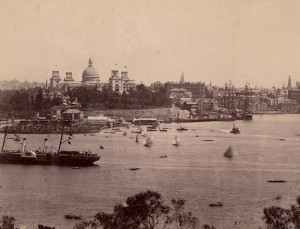 The Palace and its related buildings—Fine Art Gallery, Machinery and Agricultural Halls, ten restaurants—took up a land area of 14 hectares. The exhibition halls contained collections showcasing Australia’s industry and agriculture as well as examples of art and industry from around the world, and 2,000 items that represented the Aboriginal and Islander people.
The Palace and its related buildings—Fine Art Gallery, Machinery and Agricultural Halls, ten restaurants—took up a land area of 14 hectares. The exhibition halls contained collections showcasing Australia’s industry and agriculture as well as examples of art and industry from around the world, and 2,000 items that represented the Aboriginal and Islander people.
The exhibition halls were filled with massed items from every region and country that could be managed. The ethnological collection of spears, hunting equipment and canoes, while extensive, perpetuated the “savage” stereotype. There seemed to be little interest in sharing other stories of the native population; their culture and religions, relationships with the natural world, or their struggle with the new world imposed upon them.
This was typical of Victorian-age museums. Images of other display halls show this pattern clearly. Looking at the exhibition as a whole, it can be seen that the Ethnographical Hall where the Aboriginal and Islander items were located, showed one end of the progression of “modern” culture in its material evidence of “primitive” in contrast to the Agricultural and Mechanics halls which held the latest in industrial technology.
After the International Exhibition closed, the collections were returned, sold off, or kept in storage. The Australian Museum’s ethnological collection was permanently housed onsite.
The rest of the Palace was converted to offices, galleries, and a concert hall. Stored were government records like the recent census and railway plans (the railway was in the middle of its growth period stretching from the city into regional areas) with the bronzed Queen Victoria perpetually on guard.
The demise of the Garden Palace
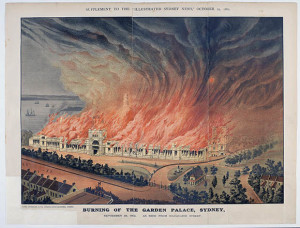 At dawn on 22 September 1882, fire ripped through the complex. The magnificent palace, built of Oregon timber and stucco, went up like a bonfire. Queen Victoria was engulfed, the census and railway plans disintegrated, and the 2,000 plus items of the Ethnological collection, their stories still waiting to be told, were turned to ember and ash.
At dawn on 22 September 1882, fire ripped through the complex. The magnificent palace, built of Oregon timber and stucco, went up like a bonfire. Queen Victoria was engulfed, the census and railway plans disintegrated, and the 2,000 plus items of the Ethnological collection, their stories still waiting to be told, were turned to ember and ash.
A year after the fire, the Royal Botanic Gardens took over the land, memorial gates were installed, and the Palace faded into history. The current museum’s ethnological collection tells a deeper story.
The recent re-emergence of the Garden Palace in collective memory reminds us of a point in time and history where the British established their control of a country with a veneer of European civilisation that became so entrenched many forgot that they were squatters on a land that did not belong to them.
Sources:
http://www.sl.nsw.gov.au/stories/garden-palace
http://kaldorartprojects.org.au/project-32-jonathan-jones
https://www.records.nsw.gov.au/archives/magazine/galleries/garden-palace-fire
https://dictionaryofsydney.org/entry/garden_palace
http://sydneyarchitecture.com/GON/GON06.htm
*****
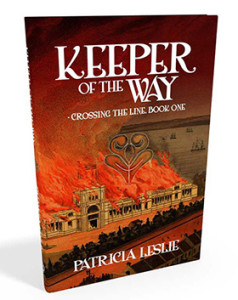 A big thanks to Patricia Leslie! She’ll give away trade paperback or Kindle ebook copy of Keeper of the Way to someone who contributes a comment on my blog this week. I’ll choose the winner from among those who comment by Friday at 6 p.m. ET. Delivery of the paperback is available in Australia and New Zealand only.
A big thanks to Patricia Leslie! She’ll give away trade paperback or Kindle ebook copy of Keeper of the Way to someone who contributes a comment on my blog this week. I’ll choose the winner from among those who comment by Friday at 6 p.m. ET. Delivery of the paperback is available in Australia and New Zealand only.
Did you like what you read? Learn about downloads, discounts, and special offers from Relevant History authors and Suzanne Adair. Subscribe to Suzanne’s free newsletter.

This is a must read! You had me at Sydney!
Hope you found it interesting. There’s so much to talk about from this period – Gadigal and British.
Patricia
What a fascinating story! Congratulations on your book.
Thanks, Vicki. this is only a tiny glimpse into the history of this period too.
Patricia
A snippet of history which I knew nothing about!
Hope I’ve tempted you to find out more
Patricia
History comes alive when we renew our understanding of it. Thank you for this excellent article.
Glad you enjoyed it, Joyce. Researching history is one of my main motivations for writing.
Patricia
What a tragedy to lose that ethnological collection, which probably meant nothing to those mourning the loss of the buildings. Fascinating story. Thanks for sharing.
Thanks John. the Australian Museum was very upset at the loss of the “first contact” collections as you could imagine. Recently there was a major art project/exhibition based on this called Spotfires. Here’s a link to an article about it: https://www.australiangeographic.com.au/news/2016/09/jonathan-jones-barrangal-dyara/
Patricia
This is fascinating! I love learning things about history that I didn’t know before, and sadly, I don’t know a lot about Australian history. Would love to read this book.
Glad to have peaked your interest. The background research for Keeper of the Way has been fascinating. the “magical” aspects in the story follow old Scot and Irish traditions and much of the mythology is Celtic and pre-Celtic. Pretty much everything I’m interested in finds a place in Keeper of the Way. A lot of fun to write!
Patricia